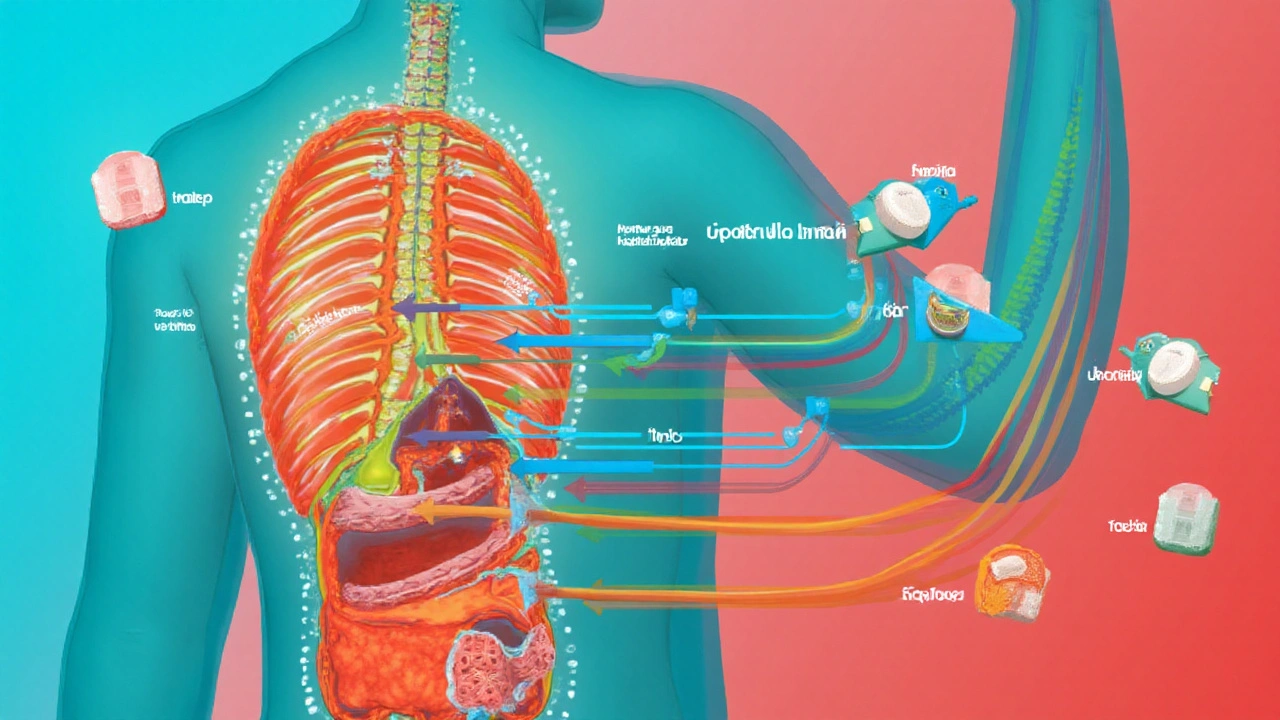Pop a pain reliever and forget about the headache, right? Most of us barely glance at the label. Grab a white oval or a round red gel, swallow, and keep moving. But inside those tiny pills lives a whole world you probably never think about—a mini chemistry lab with ingredients all gunning to mess with your pain. Some work like magic, some quietly build up risks, and others aren’t even really for pain at all. Ever wonder what’s lurking in the pill that kills your backache?
The Main Players: Breaking Down the Popular Pain Relievers
When you pick up a bottle of painkillers, you’re usually deciding between acetaminophen (think Tylenol), ibuprofen (like Advil or Motrin), aspirin, or naproxen (Aleve). Each isn’t just a different brand—they’re actually different drugs with different ways to chase pain and inflammation out of your body. Let’s zero in on what sets these guys apart.
Acetaminophen is more of a chill operator. It works in your brain, cooling off pain signals and pounding fevers. It's the go-to for headaches, toothaches, even hangovers. But it’s a quiet danger for your liver—just 3,000 to 4,000 mg is the daily limit for a healthy adult, but go above that, even accidentally, and your liver might not forgive you. Here’s something people rarely consider: it sneaks into cold medicines, sleep aids, prescription combos—easy to double dip and never realize.
Now, ibuprofen and naproxen are both what doctors call NSAIDs—nonsteroidal anti-inflammatory drugs. They’re more about quelling swelling and muscle aches. Sprained ankle, period cramps, arthritis flare? They attack the enzymes that whip up pain and inflammation (COX-1 and COX-2). The catch? These enzymes help line your stomach, so NSAIDs up the odds of ulcers and stomach bleeding. Take them with food, or you’re inviting trouble. Naproxen hangs in your system longer than ibuprofen, which means fewer doses but a bit more risk for your gut.
Aspirin feels old school, but it’s actually got some cool tricks. Besides pain, it can thin blood—heart doctors still use it after heart attacks to stave off clots. But don’t give aspirin to kids; it’s linked to Reye’s syndrome, a rare but deadly swelling of the brain and liver. Weird, right?
Which pain reliever is safest? It’s not a one-answer deal. Kidney issues? Stay away from NSAIDs. Liver disease? Give acetaminophen a rest. Any meds from your doctor? Double-check interaction risks; you’d be amazed at what can go sideways.
Inactive Ingredients: The Hidden Guests in Every Pill
Next time you read a pain reliever label, scan for "active" and then all those unpronounceable words under "inactive". These aren’t just useless fillers. Inactive ingredients—the coloring, binders, coatings, and preservatives—hold the pill together, help it slide down your throat, and boost shelf life. But they’re far from harmless for some people.
Take sodium lauryl sulfate, which sounds like something from a cleaning aisle. It helps pills dissolve, but some folks are sensitive or allergic. Same with dyes—FD&C Red No. 40 and Yellow No. 5 regularly spark reactions, especially in kids already prone to allergies or ADHD.
There’s also microcrystalline cellulose and magnesium stearate—these fillers or lubricants keep pills from gumming up equipment at the factory. Most people's bodies ignore them, but some have reported newsworthy allergies or intolerances, particularly with gluten or animal-based fillers. Even tiny traces matter if your immune system’s picky. And you won’t always know they’re there—labels aren’t as strict as you might hope.
Gelcaps bring another twist, with gelatin often from pork or beef. Not every pain reliever is vegetarian- or kosher-friendly. If you’re living with food sensitivities, religious dietary laws, or just care what’s in your medicine, scan the fine print or even call the company. People rarely do, but it’s your right to know.
One overlooked fact: changes in inactive ingredients—say, during a factory switch or new product launch—sometimes change how your body absorbs the painkiller. Suddenly the generic doesn’t hit quite like your favorite, and you’re left blaming your own body, not the pill. If your pain reliever stops working, don’t just up the dose—try comparing inactive ingredients on old and new bottles. You might spot the culprit hiding in plain sight.

The Data: What the Numbers Really Say About Risks and Benefits
Sure, pain relievers work. But they come with a price tag—and we’re not talking just dollars. Every year, about 150 million people in the U.S. alone pop an over-the-counter pain pill. Most get relief, but not everyone gets off easy. Want stats? Check out this snapshot of the numbers behind the most common ingredients:
| Pain Reliever | Max Daily Dose (Adult) | Yearly ER Visits (US) | Main Side Effects | Safe for Kids? |
|---|---|---|---|---|
| Acetaminophen | 4,000 mg | Approx. 150,000 | Liver damage, allergic reactions | Yes, at right dose |
| Ibuprofen | 3,200 mg | Approx. 100,000 | Stomach bleeding, kidney risk | Yes, at right dose |
| Aspirin | 4,000 mg | 60,000-80,000 | Stomach ulcers, bleeding, Reye’s syndrome | No (under 16) |
| Naproxen | 1,000 mg | About 30,000 | Stomach, kidney, heart risks | Sometimes (not under 12) |
Most jaw-dropping stat? Acetaminophen is the single biggest cause of acute liver failure in the U.S. It’s not some backroom black-market drug. It’s in your medicine cabinet. The main reason? Accidental overdose. You’d expect this kind of stat from the strong stuff, but it’s hiding right in your go-to headache remedy.
Ibuprofen’s biggest downside? It dings your kidneys, especially if you already have kidney issues or you’re older. Combine it with dehydration (looking at you, summer marathoners or festival goers), and things can spiral fast.
Aspirin, meanwhile, mostly trips up older people because it thins blood and makes bruises or even serious bleeds more likely. Some doctors still like it for heart patients, but the trend is turning. Risks are now seen as too high for most people to use aspirin as daily prevention.
Naproxen’s drawn attention lately for possible heart risks—especially with long-term use. One large British study flagged people regularly using prescription-strength NSAIDs for double the heart attack risk, especially above 50. The message? Painkillers aren’t candy, and the line between dose and danger is thinner than most realize.
How Pain Relievers Are Absorbed—And Why It Matters
Ever notice how some pain pills seem to work almost instantly, while others drag their heels? It’s more than just marketing. Your stomach, your liver, and even the food you ate all team up to control how fast these drugs hit the bloodstream.
Take acetaminophen—it’s a quick-dissolve champion. Most people feel relief within 20–40 minutes after taking it on an empty stomach. Swallow it with food and you might wait double that. Chewable or liquid forms work even faster; that explains why hospital ERs reach for liquid acetaminophen in emergencies.
Ibuprofen acts a little slower, especially if you take it with a heavy meal. Fatty foods can practically trap ibuprofen, holding it in your gut and dulling the punch. Ever see those “liquid gels” in stores? They break down quicker than solid tablets—perfect for sudden migraines or toothaches that just can’t wait.
Don’t ignore what your gut is telling you, either. Some painkillers rely on acid in your stomach to break them apart. But if you take heartburn meds—PPIs or antacids—they can blunt or delay the pain reliever. Suddenly “fast acting” turns into “barely acting.”
Some people buzz through the effects faster than others. Your genetics, your weight, even stuff like drinking grapefruit juice can speed up or slow down how your painkiller is absorbed or broken down by your liver. That’s why one-size-fits-all never really fits.
The other big factor: age. Kids and older adults have different enzyme speeds. Medicine doses for kids are always weight-based—never just a smaller adult dose. For people over sixty, changes in body fat and muscle, plus slower kidneys, means drugs linger longer, raising the risk of side effects and toxic build-up.
So, the big tip here? Always start with the lowest effective dose, and give it time. If one brand or form doesn’t work for you, try another—liquid, chewable, gel vs solid tab. But keep an eye on the total milligrams, so you don’t cross into dangerous territory.

Smart Tips and Surprises: Getting the Most Pain Relief with the Least Risk
Next time pain hits, you’ve got more power than you think. Step one: read that label, top to bottom. Look for duplicate ingredients (especially acetaminophen in combo pills) and watch your total daily tally. Set a phone reminder, label your drugs, and keep a pain diary if you don’t want surprises.
- Alternate between acetaminophen and an NSAID (ibuprofen or naproxen) for round-the-clock pain control—but only for a few days, and only if your body can handle both.
- Drink plenty of water when taking any painkiller, unless your doctor’s told you to limit fluids.
- Don’t mix alcohol with acetaminophen, ever. Two drinks can double your liver risk.
- If you’re training for a marathon or a big hike, don’t take ibuprofen or naproxen as “prevention”—it won’t help pain and can harm kidneys, especially in the heat.
- Watch for other prescription drugs that might clash, like blood thinners (with NSAIDs or aspirin) or anti-seizure meds (with acetaminophen).
- If your pain lasts more than a few days, or if you keep needing higher doses, see your doctor—painkillers weren’t built for the long haul.
- For fevers in kids or teens, skip aspirin. Stick to approved doses of acetaminophen or ibuprofen, and dose by weight, not age.
- Don’t trust that just because a pain reliever is “childproof” or “low dose” that it’s automatically safe. Accidents and overdoses are still common.
Don’t be afraid to ask your pharmacist for help—they see these interactions every day and can save you from missteps. If you get rashes, stomach aches, or new symptoms after starting a painkiller, stop and call for advice. Most people brush off mild reactions without realizing they’re warnings.
Here’s one more left-field surprise: painkillers aren’t the only way to fight pain. A hot shower, gentle stretching, a cold pack, or even a power nap often beat a pill, especially for mild aches. Save medicine for when you really need it.
So the next time you reach for pain relief, check what’s really inside—and what your body’s saying about it. Your headache may be screaming for a pill, but your liver, stomach, and heart are whispering, “Slow down, partner.” Give them a say, too.


